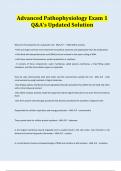Exam (elaborations)
Advanced Pathophysiology Exam 1 Q&A’s Updated Solution
- Course
- Institution
What are the signs and symptoms associated with hypernatremia - ANS - thirst, fever, dry mucous membrane, hypotension, tachycardia, restlessness, low jugular venous pressure. Why does giving insulin reduce potassium? - ANS - Insulin carries potassium back into the cell What are the signs an...
[Show more]



